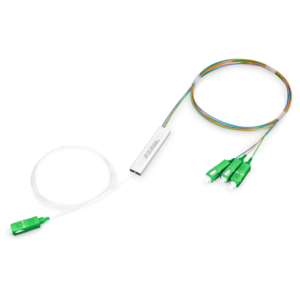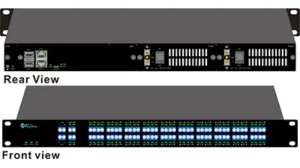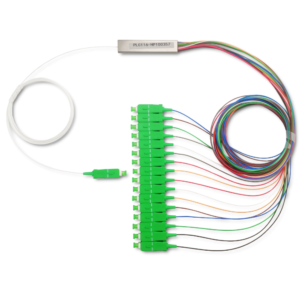Thank you for choosing to read this article. Today I will introduce you to 10Gb SFP and its important role in network communications. 10Gb SFP is a high-speed, long-distance data transmission solution that delivers superior performance and reliability for modern network connections.
Overview of 10Gb SFP
10Gb SFP (10 Gigabit Small Form-factor Pluggable) is a small-sized, high-speed optical fiber module used for data transmission in network communications. It is a pluggable module that plugs into the fiber optic interfaces of fiber optic switches, routers, servers, and other network equipment.
10Gb SFP plays an important role in network communications. It provides high-speed, reliable data transmission and can support 10 Gigabit Ethernet (10 Gigabit Ethernet) rates. It transmits data through optical fiber media, which can achieve high-bandwidth transmission over longer distances with lower signal loss and less interference.
The importance and application scenarios of 10Gb SFP are mainly reflected in the following aspects:
-
High-speed data transmission: 10Gb SFP provides a transmission rate of up to 10 gigabit per second and is suitable for application scenarios that require large amounts of data transmission. It can meet high bandwidth requirements and support the requirements for fast data transmission in large-scale data centers, cloud computing, high-performance computing, etc.
-
Long-distance transmission: 10Gb SFP uses optical fiber media for data transmission, which can achieve longer-distance transmission. The specific transmission distance depends on the type of fiber. For example, multimode fiber can support a distance of hundreds of meters, while single-mode fiber can support a transmission distance of tens of kilometers. This makes 10Gb SFP very useful in scenarios where data needs to be transferred across longer distances.
-
Flexibility and upgradeability: 10Gb SFP is pluggable and can be replaced or upgraded according to actual needs. It is compatible with different types of optical fiber interfaces, such as LC, SC, etc., to adapt to the interface requirements of different devices. This flexibility allows network administrators to adjust and upgrade as needed to meet different network requirements.
In summary, 10Gb SFP is a fiber optic module for high-speed, long-distance data transmission, which plays an important role in network communications. It is suitable for application scenarios that require high bandwidth and high speed, such as data centers, cloud computing and high-performance computing. At the same time, its pluggability and compatibility make it flexible and upgradeable in the network architecture.
10Gb SFP advantages and features
10Gb SFP (10 Gigabit Small Form-factor Pluggable) has the following advantages and features compared to traditional SFP modules:
-
Higher data transmission rate: 10Gb SFP supports the data transmission rate of 10 Gigabit Ethernet, which provides a higher transmission speed than the 1 Gigabit Ethernet rate of the traditional SFP module. This enables 10Gb SFP to meet the demand for large-capacity data transmission and support applications such as high-speed data centers, cloud computing, and large-scale data transmission.
-
Greater bandwidth capacity: Since 10Gb SFP has a higher data transfer rate, it provides greater bandwidth capacity. Bandwidth refers to the amount of data that can be transmitted per unit time, and the high rate of 10Gb SFP enables it to transmit more data at the same time to meet the demand for high bandwidth.
-
Support multimode/single mode fiber interface: 10Gb SFP module can support multimode fiber (Multimode Fiber) and single mode fiber (Single Mode Fiber) interfaces. Multimode fiber is suitable for transmission over shorter distances, while single-mode fiber is suitable for transmission over longer distances. This flexibility enables 10Gb SFP to adapt to different transmission distance requirements, ranging from tens of meters to tens of kilometers.
-
Support different transmission distances: Depending on the fiber type and fiber quality used, the 10Gb SFP module can support different transmission distances. The transmission distance of multi-mode fiber is usually in the range of several hundred meters, while the transmission distance of single-mode fiber can reach tens of kilometers. This makes 10Gb SFP flexible in different network deployment scenarios and can meet data transmission requirements at different distances.
In summary, 10Gb SFP has higher data transfer rate and greater bandwidth capacity than traditional SFP modules. Its features include supporting multi-mode/single-mode optical fiber interfaces, which can adapt to different transmission distance needs. These characteristics give 10Gb SFP important advantages in high-speed, long-distance data transmission scenarios, and are widely used in data centers, cloud computing and other network environments that require high bandwidth.
10Gb SFP application scenarios
10Gb SFP (10 Gigabit Small Form-factor Pluggable) has a wide range of application scenarios in different network equipment, mainly including the following aspects:
-
Switch: 10Gb SFP is widely used in fiber optic interface modules of fiber optic switches. It can provide high-speed, reliable data transmission and support large-capacity data exchange. In enterprise networks, switches are usually used to connect various devices, such as servers, storage devices, and workstations, and 10Gb SFP modules can meet the high-bandwidth, low-latency communication needs between these devices.
-
Routers: 10Gb SFP is also widely used in fiber optic interface modules of routers to achieve high-speed data routing and forwarding. Routers are key devices in the network. 10Gb SFP modules enable routers to handle large amounts of data traffic and support high-speed data transmission and distribution. It plays an important role in network infrastructure such as large enterprise networks, Internet Service Providers (ISPs), and telecom operators.
-
Data center: The application of 10Gb SFP in data center is very important. Data centers require high-bandwidth and high-performance networks to handle large-scale data transmission and processing tasks. 10Gb SFP modules can meet the data center’s requirements for fast data transmission, low latency and high reliability, and are used to connect servers, storage devices and network equipment to build high-speed, high-density data center networks.
-
High-performance computing: In the field of high-performance computing (HPC), 10Gb SFP is widely used to connect equipment such as supercomputers, high-performance servers, and storage systems. HPC applications require high-speed data transmission to handle complex computing tasks, and the 10Gb SFP module provides large bandwidth and high-rate transmission capabilities to meet high-performance network requirements in HPC environments.
In summary, 10Gb SFP has a wide range of application scenarios in network equipment such as switches, routers, data centers, and high-performance computing. It plays an important role in building high-bandwidth and high-performance networks, meeting the needs of large-scale data transmission, high-speed data exchange and low-latency communication.
10Gb SFP selection and deployment recommendations
Here are some recommendations and best practices when selecting and deploying 10Gb SFP (10 Gigabit Small Form-factor Pluggable) modules:
Guidance on selecting 10Gb SFP modules:
-
Network requirements: First, understand your network requirements. Determine required bandwidth and transmission distance, as well as compatibility requirements for network equipment. This will help you choose the appropriate 10Gb SFP module type and specification.
-
Fiber Interface Type: Consider the fiber interface type of your network equipment and fiber optic infrastructure. Common fiber interface types include LC, SC, ST, etc. Make sure the selected 10Gb SFP module and fiber interface type match to ensure normal connection and transmission.
-
Multi-mode/single-mode optical fiber: Choose the appropriate fiber type according to the transmission distance. Multimode fiber is suitable for shorter distance transmission, while single mode fiber is suitable for longer distance transmission. Make sure the 10Gb SFP module you choose is compatible with the fiber type used.
-
Brand and quality: Choose a reliable brand and high-quality 10Gb SFP module supplier. High-quality modules can provide stable performance and reliable data transmission, reducing failures and maintenance costs.
Deployment recommendations for 10Gb SFP modules:
-
Physical installation: Before installing the 10Gb SFP module, ensure that the device is powered off. Carefully insert the 10Gb SFP into the appropriate slot following the device manufacturer’s guidelines, making sure it is securely inserted.
-
Optical fiber connection: Before connecting the optical fiber, ensure that the optical fiber port and the optical fiber interface of the 10Gb SFP module are clean and dust-free. Connect the fiber to the 10Gb SFP module using appropriate fiber optic connectors (such as LC, SC, etc.). Make sure the connection is secure and avoid excessive bending and twisting of the fiber.
-
Configuration settings: Make necessary configuration settings according to the requirements of the network device. This may involve the device’s management interface or command line interface (CLI). Make sure to set the parameters of the 10Gb SFP module correctly, such as speed, transmission mode, etc.
-
Testing and monitoring: After deploying the 10Gb SFP module, perform testing and monitoring. Use appropriate tools and equipment to verify the stability and performance of data transfers. Monitor the working status of 10Gb SFP modules to detect and resolve potential problems in a timely manner.
In summary, when selecting and deploying 10Gb SFP modules, factors such as network requirements, fiber interface type and compatibility need to be considered. Following best practices for physical installation, fiber connections, and configuration setup can ensure proper operation and stable data transmission of 10Gb SFP modules. At the same time, the performance of the module is regularly tested and monitored to detect and solve potential problems in a timely manner.
Development Trend of 10Gb SFP
10Gb SFP (10 Gigabit Small Form-factor Pluggable) modules will continue to develop in the following directions in future development:
Future 10Gb SFP modules will develop towards higher speed, lower power consumption and smaller size designs. At the same time, combined with the development of data center needs and optical fiber networks, the innovation and application of 10Gb SFP modules will be further promoted. These development trends will help meet the growing network needs and promote the progress and development of network technology.
Summarize:
In the future, 10Gb SFP will continue to develop to achieve higher speed, lower power consumption and smaller size designs. At the same time, the combination of 10Gb SFP with emerging network technologies, such as the needs of data centers and the development of optical fiber networks, will further promote its development and application.
If you are interested in 10Gb SFP, please consider contacting us, we will provide you with professional advice and support to help you choose a 10Gb SFP solution that suits your needs and achieve high-speed, reliable network communications.
- What is a 10Gb SFP?
- Can SFP run 10G?
- Is SFP 1G or 10G?
- Will 25G SFP work in 10G?
- Is SFP 10G SR single mode or multimode?
- How do I know if my SFP is 10G?
- What is the difference between 10G SFP and 10G SFP+?
- Can SFP28 run at 10Gb?
- What is the difference between 10G and 25g SFP?




